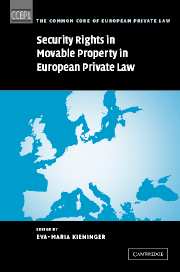Book contents
- Frontmatter
- Contents
- General editors' preface
- Preface
- List of contributors
- Table of cases cited by name
- Table of legislation
- Part I Introduction and context
- List of abbreviations
- 1 Introduction: security rights in movable property within the common market and the approach of the study
- 2 A labyrinth of creditors: a short introduction to the history of security interests in goods
- 3 Security in movables in the United States – Uniform Commercial Code Article 9: a basis for comparison
- 4 The English law of security: creditor-friendly but unreformed
- 5 The European Bank for Reconstruction and Development's Secured Transactions Project: a model law and ten core principles for a modern secured transactions law in countries of Central and Eastern Europe (and elsewhere!)
- Part II The case studies
- Index by country
- Index by subject
3 - Security in movables in the United States – Uniform Commercial Code Article 9: a basis for comparison
Published online by Cambridge University Press: 23 December 2009
- Frontmatter
- Contents
- General editors' preface
- Preface
- List of contributors
- Table of cases cited by name
- Table of legislation
- Part I Introduction and context
- List of abbreviations
- 1 Introduction: security rights in movable property within the common market and the approach of the study
- 2 A labyrinth of creditors: a short introduction to the history of security interests in goods
- 3 Security in movables in the United States – Uniform Commercial Code Article 9: a basis for comparison
- 4 The English law of security: creditor-friendly but unreformed
- 5 The European Bank for Reconstruction and Development's Secured Transactions Project: a model law and ten core principles for a modern secured transactions law in countries of Central and Eastern Europe (and elsewhere!)
- Part II The case studies
- Index by country
- Index by subject
Summary
The purpose of this chapter is to provide the reader with an opportunity to compare movables security law in Europe, particularly this volume's discussion of its common core, with the corresponding body of law in the United States. This chapter will describe the approach taken in the US, an approach that has already had significant influence beyond the borders, ranging from a substantially complete adoption in virtually all of the provinces of Canada, to visible impact in the formulation of the EBRD Model Law on Secured Transactions (1994), the United Nations Convention on Assignment of Receivables in International Trade (approved by the General Assembly in 2001), the UNIDROIT Convention on International Interests in Mobile Equipment (recently approved at the diplomatic conference in Cape Town), and the OAS Model Inter-American Law on Secured Transactions (recently approved at the sixth Inter-American Specialized Conference on Private International Law) and to direct or indirect influence on contemporary reform legislation in New Zealand, Eastern Europe, Mexico and elsewhere.
Article 9, part of the Uniform Commercial Code (“UCC”), is a substantial piece of legislation, first enacted in the early 1950s, that seeks to facilitate financing secured by “personal property” (i.e., movables, whether tangible or intangible, as distinct from “real property”, i.e., land and buildings) by making such financing more efficient, economical and widely available.
- Type
- Chapter
- Information
- Publisher: Cambridge University PressPrint publication year: 2004



